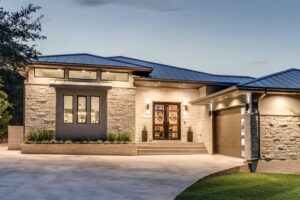Prairie-style architecture was founded by Frank Lloyd Wright and a group of young architects that Wright would refer to as The New School of the Middle West. The movement came after the Great Chicago Fire of 1871. The devastation opened up several new building opportunities for young architects.
After the Chicago World’s Fair in 1893, many architects were disappointed with the Classical Revival styles presented during the expo. Wright and a group of colleges began to work rigorously to create a new, unheard-of style that would become an unconventional reflection of American life in the Midwest. This architectural style officially emerged in Chicago around 1900 and remained a part of the public eye until around 1915.
This innovative aesthetic became known as Prairie style when Wright published building plans entitled “A House in a Prairie Town” in 1901. Although this is a short-lived building style, its influence can be seen throughout Modern architecture.
What makes a house a Prairie Style?
Wright thought of a Prairie-style house as a structure that was married to the ground. In other words, he intended to create structures that replicated the flat, bare landscape of the American Midwest. In doing so, he and his colleagues incorporated several key characteristics into their work.
Horizontal lines. Many surfaces were positioned in horizontal ways, which is in contrast to the Art Deco movement that had surfaces pointed upwards. Gutter downspouts and other vertical elements were hidden in Prairie-style homes. Cantilevered roofs were long, horizontal, and flat.
Handmade craftsmanship. Similar to the Arts and Crafts movement, Prairie-style homes incorporated a lot of hand-wrought woodwork and art glass. However, most enhancements were subtly built into the structure and were not overly excessive or detailed. Windows served as art, and a lot of furniture was made in place. This concept of built-in art and furniture prevented new owners from adding non-essentials into the home.
Simple and natural woodwork. This style wanted natural elements to shine in their pure form. The woodwork was kept simple and incorporated smooth wood bands so the wood grain could be admired.
Where to look in Denver
You can see Prairie Style houses at the following addresses: 3400 Federal Boulevard (Frank Milton House was built in 1916, this is Denver’s best example of a Prairie Style home), 750 Emerson (built in 1916 is a beautiful manifestation of Frank Lloyd Wright’s insistence that built structure be in harmony with its environment), 642 Clarkson (built in 1923, the wide rectangular front window reinforced by small rectangle openings, with deep, projecting eaves emphasize the horizontality so important to the Prairie Style).
Sources: https://www.thespruce.com/, https://leonardleonard.com/

https://www.behance.net/

https://www.houseplans.com/

https://www.rowlandbroughton.com/

https://www.rowlandbroughton.com/
